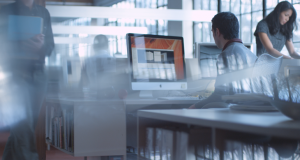 It’s no good pointing out to these people that the office has gone paperless
It’s no good pointing out to these people that the office has gone paperlessThe growth of computing as the cornerstone to running a successful business has meant that organisations are naturally inclined towards conducting all operations in a virtual environment, but is this insistence upon a clear desk actually an impediment to creative thinking?
In the good old days of the traditional office, employees could barely see each other over piles of paper, the clutter of photographs, and pot plants muddling the working space; however, times have changed and phrases such as ‘paperless environment’, ‘cloud-based knowledge management’, ‘hot-desking’ and ‘clear-desk policies’ seem to be the buzzwords of any modern, streamlined office space.
The advent of new technologies enabling an organisation’s entire operation to be conducted virtually has had a greater effect upon the dynamics of business. While modern working practices have evolved and space is at a premium, the fundamental culture associated with effective working has changed.
With employers opting for more flexible working arrangements, such as remote log-in, it makes absolute sense to move from dedicated employee desks to a more peripatetic seating model; however, one of the first things to be lost in a virtual-dependent reality is the various accoutrements that make an employee’s desk a home from home.
While this clear desk policy is logical, it is possible that it is not conducive to creativity. Apart from the simple issues stemming from baseless employees, such as lowered morale and a decreased sense of identity in the workplace, could the insistence upon impersonality in the work place be detrimental to ideas generation?
When we are children, we rely upon a variety of ‘props’ to create stories; for example, dolls, figurines and plasticine lend themselves to creative play, with sensory input leading to imaginative discovery. As adults, we may shun the childhood tools that prompted us to play freely, but some elements of the human psyche still yearn for stimulus.
Take the examples of the stress ball, the zen garden and pictures. These items cater to the fundamental needs of our sub-conscious that plasticine provided in our youth. When we are tapping into creativity, we reach for something to fiddle with, to doodle, to distract us physically while our mind roams freely. This is the essence of the creative process – accessing various tools that enable us to deploy the required side of our brain that generates genius.
A clear, barren office environment stultifies this process. If we are unable to use colour, sensory stimulation and mindfulness through play as adults, we are in danger of losing innovation in favour of absolute sterility. It has long been recognised that adults require stimulation, in the same way as children, to shed our inhibitions and linear thinking to produce innovative, ‘out of the box’ solutions to business issues.
Next time your management stresses the benefits of a paperless, hot-desking, clear-desk environment, consider bringing in some plasticine to combat the strictures of this restricting trend in the office dynamic and see what ensues!
Join Over 40,000 Recruiters. Get our latest articles weekly, all FREE – SEND ME ARTICLES
Recruiters love this COMPLETE set of Accredited Recruitment & HR Training – View Training Brochure








